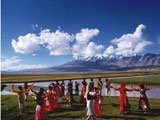 Many people know of Hetian because of the jade it produces. In fact, this small city in the south of the Xinjiang Uygur Autonomous Region was well known in ancient times, and as you arrive in Hetian, you?ll find its charm extends far beyond the production and sculpture of jade.
Many people know of Hetian because of the jade it produces. In fact, this small city in the south of the Xinjiang Uygur Autonomous Region was well known in ancient times, and as you arrive in Hetian, you?ll find its charm extends far beyond the production and sculpture of jade.
Hetian is the most southerly city in Xinjiang. There are no tall buildings here. The most eye-catching piece of architecture is the Hetian Hotel, the only one in town that is open to foreigners. The streets are wide, and when few pedestrians are on them, they seem to stretch to the horizon.
Hetian was once a vibrant trading center on the ancient Silk Road. Though the city does not bustle today the way it once did, it has department stores, karaoke and disco bars, restaurants and the other trappings of modern life.
Hetian is strongly influenced by Islamic culture. Wandering around the city, you can find Islamic architecture and features on almost every street corner. However, over two thousand years ago, Hetian was the channel through which Buddhism was introduced from India into central China. Hundreds of monks used to live here. And Xuanzang, the famous Tang Dynasty Buddhist scholar whose journey to India became the theme of the classic novel Pilgrimage to the West, is believed to have lived and preached here.
Buddhism prevailed in Hetian for hundreds of years until the 11th century A.D., when Islam began to spread through Xinjiang So far, the ruins of some 20 ancient Buddhist settlements have been unearthed here, along with a wealth of Buddhist relics, including statues, frescoes and ritual instruments. The Rewak Temple complex south of the downtown area is the most famous Buddhist ruins in Hetian.
In addition to the many historical sites, tourists can also go to the Hetian Museum in the city center, to gain an insight to the long history and culture of this ancient city.
The traditions of the local people, happily, are alive and well. The city has a population of some 140 thousand, 90 percent of which are from the Uygur ethnic group. They usually wear a little embroidered hat to distinguish themselves from the Uygur people of other places.
Almost every family here grows grapes. And the area under the grape trellises in each courtyard is where locals gather to chat, play chess and embroider garments.
The local people are proud that Hetian is the home of the music and dance of the Uygur People. Over 500 years ago, an Uygur girl in Hetian called Amatisa collected and arranged a large number of classical music pieces and songs, and in doing so created the 12 Mukams.
Mukam is the transliteration of an Arabic word meaning "melody" or "classical music". The 12 Mukams comprise 12 divertimentos, including classical and folk ballads and songs, dance music and instrumental music. The 12 Mukams are considered the very heart and soul of the rich and melodious Uygur music, and are still very popular today.
The local people in Hetian are very hospitable. When important guests arrive, they hold a welcoming party in the courtyard on the red carpeted stage under the grape trellis. Everybody is welcome to join in the singing and dancing.
In the bazaars of the city, you can find a huge variety of traditional local handicrafts, such as copper kettles and wooden bowls. But for many tourists, a trip to Hetian is not complete unless you buy at least one of the city?s prized goods - jade, silk and carpets. These are known as the three treasures of Hetian.
In the Uygur language, the word hetian means "a place that abounds in jade". As its name indicates, Hetian is one of the best known jade-producing areas in China and right around the world. The exquisitely-sculpted jade products are considered precious works of art, and have been shipped abroad to foreign countries since ancient times. In the jade shopping streets of the bazaars, you can find all kinds of Hetian jade. But if you want to buy higher-quality jade wares, the Hetian Arts and Crafts Company is the best choice.
The history of hand-woven silk and wool carpets in Hetian stretches back some two thousand years. With their bright colors, beautiful designs, strong Uygur ethnic flavor and superb craftsmanship, they remain huge favorites with tourists from home and abroad.
There is no railway line passing through Hetian. To get there, you first have to go to Urumqi, the capital of the Xinjiang Uygur Autonomous Region, and then take a plane or a long-distance bus to Hetian.
(CRI November 14, 2002)
|

